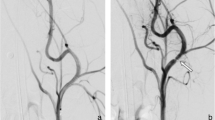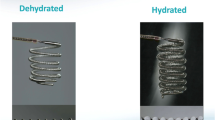Abstract
Introduction
The aim of the study was to compare standard platinum Guglielmi detachable coils (GDC) with coated platinum coils (Matrix; both Boston Scientific, Fremont, CA) regarding handling, complications, occlusion and recanalization rate after 3 and 6Â months.
Methods
Aneurysms in the right common carotid artery were created in 25 rabbits. The animals were divided into five groups of five animals each. The animals of group 1 (the control group) received no treatment of the induced aneurysms, the animals of groups 2 and 3 (killed at 3 and 6Â months) were treated with standard GDC, and the animals of groups 4 and 5 (killed at 3 and 6Â months) were treated with Matrix coils.
Results
Histopathological evaluation showed organized thrombus formation and connective tissue with neovascularization around the implanted coils in all the treated groups. The achieved occlusion rates in groups 2 and 3 were identical to those in groups 4 and 5. Thus the long-term results of aneurysm treatment with GDC and Matrix coils show no differences regarding occlusion and recanalization rates. The only noticeable difference was the difference in handling. More force was required to pushing the Matrix coils forward through the microcatheter and there was more friction in coil interaction in the aneurysm.
Conclusion
The bioactive coating of the Matrix coil produces no significant benefit in achieving higher occlusion and lower recanalization rates, and the coil is more difficult to handle. Future bioactive coils must be shown to produce significantly better long-term results than GDC and their ease of handling has to be improved.








Similar content being viewed by others
References
Grunwald IQ, Romeike BF, Roth C et al (2005) Anticoagulation regimes and their influence on the occlusion rate of aneurysms: an experimental study in rabbits. Neurosurgery 57(5):1048–1055
Ding YH, Dai D, Lewis DA et al (2005) Intra-venous digital subtraction angiography: an alternative method to intra-arterial digital subtraction angiography for experimental aneurysm imaging. Neuroradiology 47(10):792–795
Cognard C, Pierot L, Boulin A et al (1997) Intracranial aneurysms: endovascular treatment with mechanical detachable spirals in 60 aneurysms. Radiology 202(3):783–792
Cognard C, Weill A, Castaings L et al (1998) Intracranial berry aneurysms: angiographic and clinical results after endovascular treatment. Radiology 206(2):499–510
Cognard C, Weill A, Spelle L et al (1999) Long-term angiographic follow-up of 169 intracranial berry aneurysms occluded with detachable coils. Radiology 212(2):348–356
Sluzewski M, van Rooij J, Slob MJ et al (2004) Relation between aneurysm volume, packing, and compaction in 145 cerebral aneurysms treated with coils. Radiology 231(3):653–658
Tamatani S, Ito Y, Abe H et al (2002) Evaluation of the stability of aneurysms after embolization using detachable coils: correlation between stability of aneurysms and embolized volume of aneurysms. AJNR Am J Neuroradiol 23(5):762–767
Murayama Y, Viñuela S, Ishii A et al (2006) Initial clinical experience with matrix detachable coils for the treatment of intracranial aneurysms. J Neurosurg 105(2):192–199
Grunwald IQ, Papanagiotou P, Politi M et al (2006) Endovascular treatment of unruptured intracranial aneurysms: occurrence of thromboembolic events. Neurosurgery 58(4):612–618
Byrne JV, Sohn MJ, Molyneux AJ et al (1999) Five-year experience in using coil embolization for ruptured intracranial aneurysms: outcomes and incidence of late rebleeding. J Neurosurg 90(4):656–663
Grunwald IQ, Papanagiotou P, Struffert T et al (2007) Recanalization after endovascular treatment of intracerebral aneurysms. Neuroradiology 49(1):41–47
Katsaridis V, Papagiannaki C, Violaris C (2006) Guglielmi detachable coils versus matrix coils: a comparison of the immediate posttreatment results of the embolization of 364 cerebral aneurysms in 307 patients: a single-center, single-surgeon experience. AJNR Am J Neuroradiol 27(9):1841–1848
Rossitti S (2007) Endovascular coiling of intracranial aneurysms using bioactive coils: a single-center study. Acta Radiol 48(5):565–576
Wong GK, Yu SC, Poon WS (2007) Clinical and angiographic outcome of intracranial aneurysms treated with Matrix detachable coils in Chinese patients. Surg Neurol 67(2):122–126
Taschner CA, Leclerc X, Rachdi H et al (2005) Matrix detachable coils for the endovascular treatment of intracranial aneurysms: analysis of early angiographic and clinical outcomes. Stroke 36(10):2176–2180
Murayama Y, Tateshima S, Gonzales NR et al (2003) Matrix and bioabsorbable polymeric coils accelerate healing of intracranial aneurysms: long-term experimental study. Stroke 34(8):2031–2037
Akiba Y, Murayama Y, Viñuela F et al (1999) Balloon-assisted Guglielmi detachable coiling of wide-necked aneurysms: Part I – experimental evaluation. Neurosurgery 45(3):519–527
Forrest MD, O’Reilly GV (1989) Production of experimental aneurysms at a surgically created arterial bifurcation. AJNR Am J Neuroradiol 10(2):400–402
Kerber CW, Heilman CB (1992) Flow dynamics in the human carotid artery: I. Preliminary observations using a transparent elastic model. AJNR Am J Neuroradiol 13(1):173–180
Kerber CW, Liepsch D (1994) Flow dynamics for radiologists. II. Practical considerations in the live human. AJNR Am J Neuroradiol 15(6):1076–1086
Kerber CW, Liepsch D (1994) Flow dynamics for radiologists. I. Basic principles of fluid flow. AJNR Am J Neuroradiol 15(6):1065–1075
Song JK, Niimi Y, Yoshino Y et al (2007) Assessment of Matrix coils in a canine model of a large bifurcation aneurysm. Neuroradiology 49(3):231–235
Pierot L, Bonafé A, Bracard S et al (2006) Endovascular treatment of intracranial aneurysms with matrix detachable coils: immediate posttreatment results from a prospective multicenter registry. AJNR Am J Neuroradiol 27(8):1693–1699
Kang HS, Han MH, Kwon BJ et al (2005) Short-term outcome of intracranial aneurysms treated with polyglycolic acid/lactide copolymer-coated coils compared to historical controls treated with bare platinum coils: a single-center experience. AJNR Am J Neuroradiol 26(8):1921–1928
Linfante I, Akkawi NM, Perlow A et al (2005) Polyglycolide/polylactide-coated platinum coils for patients with ruptured and unruptured cerebral aneurysms: a single-center experience. Stroke 36(9):1948–1953
Carter LP, Guthkelch AN, Orozco J et al (1992) Influence of tissue plasminogen activator and heparin on cerebral ischemia in a rabbit model. Stroke 23(6):883–888
Cloft HJ, Altes TA, Marx WF et al (1999) Endovascular creation of an in vivo bifurcation aneurysm model in rabbits. Radiology 213(1):223–228
Conflict of interest statement
We declare that we have no conflict of interest.
Author information
Authors and Affiliations
Corresponding author
Rights and permissions
About this article
Cite this article
Roth, C., Struffert, T., Grunwald, I.Q. et al. Long-term results with Matrix coils vs. GDC: an angiographic and histopathological comparison. Neuroradiology 50, 693–699 (2008). https://doi.org/10.1007/s00234-008-0392-8
Received:
Accepted:
Published:
Issue Date:
DOI: https://doi.org/10.1007/s00234-008-0392-8




